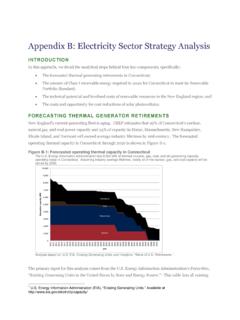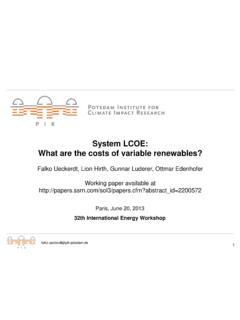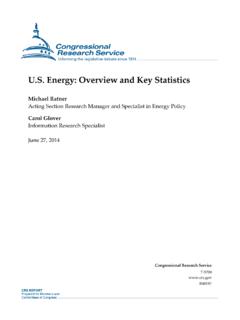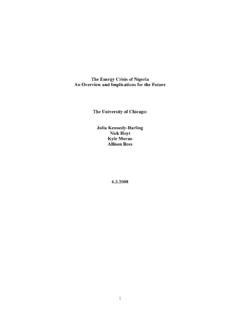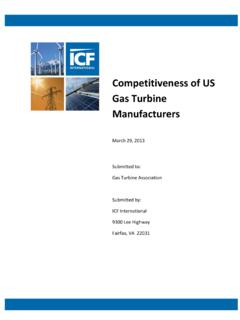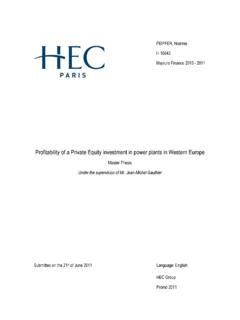Transcription of Combined cycle heat rates at simple cycle $/kW …
1 22 GAS TURBINE WORLD: March April 2013 Cheng Power Systems is telling utilities that simple cycle gas turbine plants equipped for Cheng cycle operation are able to produce more electricity at lower cost than any Combined cycle plant designed around the same model gas turbine(s). Both cycles are based on recover-ing and utilizing waste energy in the gas turbine exhaust to improve per-formance. The Cheng cycle differs in that the energy is recycled directly and more effectively through the gas turbine instead of through a separate steam turbine generator. In effect, the steam turbine and associated equipment are eliminated. Comparable plant site requirements, conversion costs and performance:o Plant site. Combined cycles re-quire three times the land and twice the water of Cheng cycle plants which typically operate on less than half the water Combined cycles lose to air cooling tower evaporation.
2 O Conversion. Cost of retrofitting a simple cycle LM6000PC gas turbine plant for Cheng cycle is estimated at around $15 million, less than half the $33 million estimate for Combined cycle conversion. o Output. Cheng cycle has the po-tential to increase simple cycle gas turbine output by up to 70% and low-er the heat rate by 40%, depending on gas turbine s OEM design project cost factors for the util-ity industry are centered on capital costs, fuel prices, emissions, operat-ing and maintenance costs. To mini-mize those costs, the gas turbine in-dustry has regularly invested large sums on improving efficiency and unit power output to reduce fuel con-sumption and lower $/kW. Currently, with the discovery of shale gas, the $8/MMBtu (LHV) price of long-term natural gas fuel supply contracts in the US has dropped to somewhere below $ , with spot market prices dip-ping to below $ , so that the price of fuel has diminished in importance.
3 Top priority for both utilities and gas turbine OEMs has switched to faster response times, to support vari-ability in intermittent wind and solar power generation, and higher part-load efficiencies. Flexible GT designs This has given rise to a new breed of flexible gas turbines such as Gener-al Electric OpFlex and Siemens Flex Plant series which are designed for rapid start grid back-up, low turn-down idling capability, cyclic opera-tion, high ramp rates (up and down), and good part-load efficiencies. General Electric s new flexible Fr 7FA-05 will introduce a new family of compressor designs with dramati-cally improved surge margin and op-erating stability, capable of higher to 1 pressure ratios and 1145 lb/sec mass flow. Earlier E-class gas turbines like the 7111EA needed 17 stages of compres-sion to achieve a 13 to 1 pressure ra-tio.
4 By contrast, the new FA-05 class could operate at a 20 to 1 pressure ratio. In simple cycle mode, the 7FA-05 is ISO rated at base load and 8830 Btu/kWh LHV heat rate ( efficiency). If modified for Combined cycle heat rates at simple cycle $/kW plant costsBy Victor deBiasi Fast full-load startup features make Cheng cycle plants ideally suited for renewable energy backup to support solar and wind efficiency. Cheng cycle operation is optimized to operate at peak plant efficiencies as determined by gas turbine compressor pressure ratio (CPR) and turbine inlet firing temperature 40 CPR 30 CPR 20 CPR 10 Turbine Inlet Temperature 60% 55 50 45 40 351500 F2000 F2500 F3000 F3500 FSource: Cheng Power Systems, March 2013 GAS TURBINE WORLD: March April 2013 23 Single 3-on-1 Single 2-on-1 Cheng CyclePlant configuration 7111EA CC plant 7FA-05 CC plant Fr 7FA-05 plantNumber of gas turbines 3 GTs 2 GTs 2 GTsNumber of boilers 3 HRSGs 2 HRSGs 2 HRSGsNumber of steam turbines 1 ST 1 ST 0 Plant design rating Nominal net plant output 363 MW 645 MW 720 MW Net plant heat rate (HHV) 8,230 Btu/kWh 6,414 Btu/kWh 7,353 Btu/kWh Net plant efficiency (HHV) Capital cost estimate Installed cost ($/kW) $950 per kW $1,000 per kW $700 per kWTotal plant cost $344,850,000 $645,000,000 $504,000,000 O&M cost estimate ($/yr)
5 40% capacity factor (2,468 hrs) $20,882,000 $25,845,000 $21,267,00060% utilization (3,702 hrs) $22,413,000 $28,469,000 $24,736,00080% utilization (4,936 hrs) $25,142,000 $33,220,000 $28,760,000 Operating heat rate (HHV) 40% capacity factor 9461 Btu/kWh 6895 Btu/kWh 7835 Btu/kWh 60% capacity factor 9737 6991 789280% capacity factor 9461 6895 7835 Fuel consumption (Btu/yr) 40% capacity factor (2,468 hrs) 8,475,959 MM Btu 10,975,875 MM Btu 13,922,482 MM Btu60% utilization (3,702 hrs) 13,084,834 16,693,040 21,035,65280% utilization (4,936 hrs) 16,951,917 21,951,749 27,844,963 Power production (MWh/yr) 40% capacity factor (2,468 hrs) 895,884 MWh 1,591,860 MWh 1,776,960 MWh60% utilization (3,702 hrs) 1,343,826 2,387,790 2,665,44080% utilization (4,936 hrs) 1,791,768 3,183,720 3,553,920 Cost of electricity * 40% capacity factor (2,468 hrs) cents/kWh cents/kWh cents/kWh60% utilization (3,702 hrs) utilization (4,936 hrs) * Estimate, COE will vary for specific projects depending on actual plant, utilization, fuel and financing costs.
6 Source: Cheng Power Systems, March 2013. Cheng comparative Combined cycle owning and operating cost studyStudy is based on conceptual 3-on-1 Fr 7111EA and 2-on-1 Fr 7FA-05 Combined cycle plant designs vs. two simple cycle Fr 7FA-05 gas turbines equipped for Cheng cycle operation (without steam turbine cycle ) operating a 5-day week, daily cycling and weekend shutdowns. Levelized cost of electricity is based on $4 per MMBtu fuel and 25-year utility financing GAS TURBINE WORLD: March April 2013 Cheng cycle operation, basically the same engine could be upgraded to base load (65% boost in power) and 6685 Btu/kWh heat rate LHV which is equivalent to cost study Cheng Power Systems recently com-pleted a study on annual owning and operating costs of contemporary 7E and more advanced FA-05 gas turbine Combined cycle plants vs.
7 Two simple cycle FA-05 gas turbines equipped for Cheng cycle operation. Fuel consumption and mainte-nance costs are calculated for base load output at 40%, 60% and 80% ca-pacity factors which take into account the impact of start-stop cycles on heat rate (fuel consumption) and mainte-nance costs. In this context, the term capac-ity factor is intended to represent the percentage of time a plant is utilized during the year at full load output. Duty cycle is based on 5 days per week of operation with daily start-stop cycling between weekend shut-downs. The Cheng study parameters are modeled on those for an EPRI-funded Sargent & Lundy study in 1989 on annual owning and operating costs for a contemporary 3-on-1 Fr 7EA Combined cycle , new (at that time) advanced 2-on-1 Fr 7FA Combined cycle plant and a steam injected LM5000 simple cycle gas turbine.
8 The new study is based on year 2012 design ratings for a 3-on-1 Fr 7111EA and advanced 2-on-1 Fr 7FA-05 Combined cycle plants vs. poten-tial plant powered by two simple cy-cle Fr 7FA-05 gas turbines modified and equipped for Cheng factors Manpower costs to operate and main-tain each of the plants are calculated on the basis of current average sal-ary levels. The percentage of the total ownership cost set aside for main-tenance follows the same format as used for the earlier EPRI Report. Fuel cost is based on a project-ed $4/MM Btu price of natural gas (HHV) delivered under a long term supply contract. Base load heat rates used for calculating fuel consump-tion are adjusted for the differences in duty cycle at 40, 60 and 80% capacity factors. Frequent start-stop cycling will increase fuel consumption because of inefficiency during plant start-up before reaching full load output and during the time required to gradually reduce load during shut-down.
9 Plants operating at 40% capacity factor operating less than 9-10 hours a day will have fewer start-stop cycles than plants at 60% in service 14-15 hours of the day. Similarly, plants at 80% factor operating up to 19 hours a day will have fewer start-stop cycles (similar to 40% operation). Multiplier factors based on in-CHP steam and power tradeoff. This is a performance map for 501KH San Jose State s Cheng plant. Trajectory line defines all the peak efficiency condi-tions of gas turbine compressor pressure and firing temperature F 1800 F 1600 F 1500 F w/o kg/s kg/sTrajectory of peak efficiencySimple cycle GT 40% 38 36 34 32 30 28 26 Source: Cheng Power Systems, March 2013 Horsepower4000hp5000hp6000hp7000hpFr 7FA-05 Fishnet. Cheng cycle operating map for advanced 7FA-05 gas tur-bine shows power increase to from (for a 12% steam-to-air ratio) and efficiency going to from Btu/kWh3% steam 1700 F 1900 F 2100 F 2300 F 6% steam 9% steam 12% steam Power output (MW) 9500 9000 8500 8000 7500 7000 Source: Cheng Power Systems, March 2013110MW160210260310 360 Trajectory of peak efficiencySimple cycle GT GAS TURBINE WORLD: March April 2013 25 dustry experience in the operation of Combined cycle plants in intermittent and base load services are used to ad-just full output heat rates to reflect the impact of cycling on fuel consump-tion.
10 For the 3-on-1 Fr7EA plant, the multiplier is times the OEM plant design heat rate for 40% ca-pacity factor (fewer startups); multiplier for 60% capacity factor op-eration (more frequent starts and shut-downs); and multiplier for 80% capacity factor levels (fewer startups). Adjusted heat rates for the single 2-on-1 7FA-05 CC plant is based on half the regular Combined cycle mul-tipliers. For the Cheng cycle plant, the multiplier is for the 40% and 80% capacity factors and for 60% capacity operation. Based on a projected long term natural gas fuel price of $4 per MM Btu, and estimated 30 percent low-er $/kW plant cost, the Cheng cycle plant shows the lowest cost of elec-tricity and, therefore, a better return on investment than building a com-bined cycle cycle features The Cheng cycle is basically a feed-back heat recovery cycle , with ef-ficiency maximized by ever changing steam-to-air ratios highly tuned to gas turbine operating parameters.

